各种时态的主动语态和被动语态
- 格式:doc
- 大小:28.00 KB
- 文档页数:1
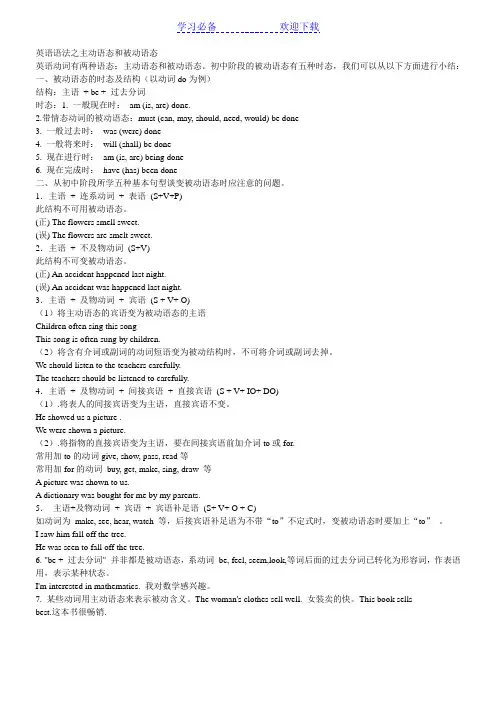
英语语法之主动语态和被动语态英语动词有两种语态:主动语态和被动语态。
初中阶段的被动语态有五种时态,我们可以从以下方面进行小结:一、被动语态的时态及结构(以动词do为例)结构:主语+ be + 过去分词时态:1. 一般现在时:am (is, are) done.2.带情态动词的被动语态:must (can, may, should, need, would) be done3. 一般过去时:was (were) done4. 一般将来时:will (shall) be done5. 现在进行时:am (is, are) being done6. 现在完成时:have (has) been done二、从初中阶段所学五种基本句型谈变被动语态时应注意的问题。
1.主语+ 连系动词+ 表语(S+V+P)此结构不可用被动语态。
(正) The flowers smell sweet.(误) The flowers are smelt sweet.2.主语+ 不及物动词(S+V)此结构不可变被动语态。
(正) An accident happened last night.(误) An accident was happened last night.3.主语+ 及物动词+ 宾语(S + V+ O)(1)将主动语态的宾语变为被动语态的主语Children often sing this songThis song is often sung by children.(2)将含有介词或副词的动词短语变为被动结构时,不可将介词或副词去掉。
We should listen to the teachers carefully.The teachers should be listened to carefully.4.主语+ 及物动词+ 间接宾语+ 直接宾语(S + V+ IO+ DO)(1).将表人的间接宾语变为主语,直接宾语不变。
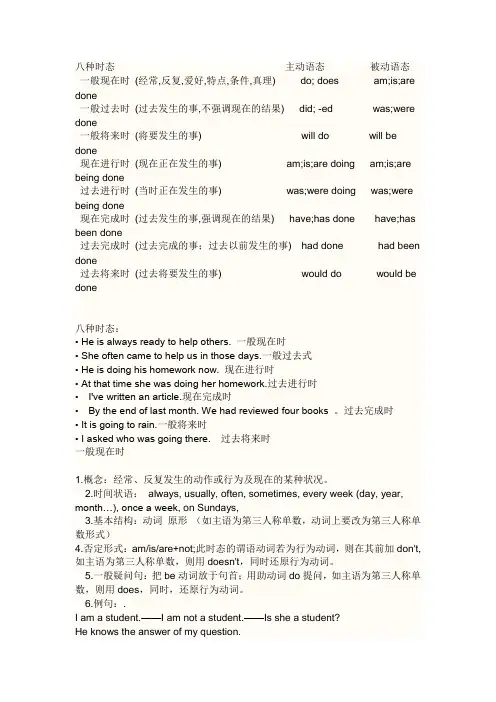
八种时态主动语态被动语态一般现在时(经常,反复,爱好,特点,条件,真理) do; does am;is;are done一般过去时(过去发生的事,不强调现在的结果) did; -ed was;were done一般将来时(将要发生的事) will do will be done现在进行时(现在正在发生的事) am;is;are doing am;is;are being done过去进行时(当时正在发生的事) was;were doing was;were being done现在完成时(过去发生的事,强调现在的结果) have;has done have;has been done过去完成时(过去完成的事;过去以前发生的事) had done had been done过去将来时(过去将要发生的事) would do would be done八种时态:• He is always ready to help others. 一般现在时• She often came to help us in those days.一般过去式• He is doing his homework now. 现在进行时• At that time she was doing her homework.过去进行时• I've written an article.现在完成时• By the end of last month. We had reviewed four books 。
过去完成时• It is going to rain.一般将来时• I asked who was going there. 过去将来时一般现在时1.概念:经常、反复发生的动作或行为及现在的某种状况。
2.时间状语:always, usually, often, sometimes, every week (day, year, month…), once a week, on Sundays,3.基本结构:动词原形(如主语为第三人称单数,动词上要改为第三人称单数形式)4.否定形式:am/is/are+not;此时态的谓语动词若为行为动词,则在其前加don't,如主语为第三人称单数,则用doesn't,同时还原行为动词。
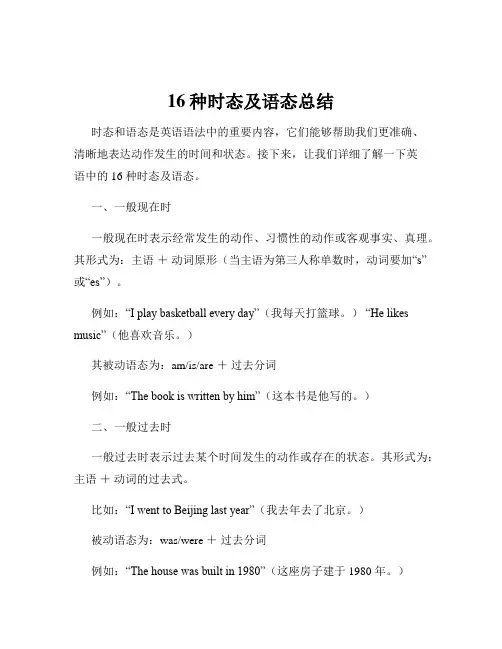
16种时态及语态总结时态和语态是英语语法中的重要内容,它们能够帮助我们更准确、清晰地表达动作发生的时间和状态。
接下来,让我们详细了解一下英语中的 16 种时态及语态。
一、一般现在时一般现在时表示经常发生的动作、习惯性的动作或客观事实、真理。
其形式为:主语+动词原形(当主语为第三人称单数时,动词要加“s”或“es”)。
例如:“I play basketball every day”(我每天打篮球。
)“He likes music”(他喜欢音乐。
)其被动语态为:am/is/are +过去分词例如:“The book is written by him”(这本书是他写的。
)二、一般过去时一般过去时表示过去某个时间发生的动作或存在的状态。
其形式为:主语+动词的过去式。
比如:“I went to Beijing last year”(我去年去了北京。
)被动语态为:was/were +过去分词例如:“The house was built in 1980”(这座房子建于 1980 年。
)三、一般将来时一般将来时表示将来要发生的动作或存在的状态。
常见形式有:will +动词原形;be going to +动词原形。
例如:“I will visit my grandparents next week”(下周我将看望我的祖父母。
)“She is going to have a party”(她打算举办一个聚会。
)其被动语态为:will be +过去分词;be going to be +过去分词例如:“The meeting will be held tomorrow”(会议将在明天举行。
)“The sports meeting is going to be cancelled”(运动会将要被取消。
)四、过去将来时过去将来时表示从过去的某一时间来看将来要发生的动作或存在的状态。
其形式为:would +动词原形;was/were going to +动词原形。
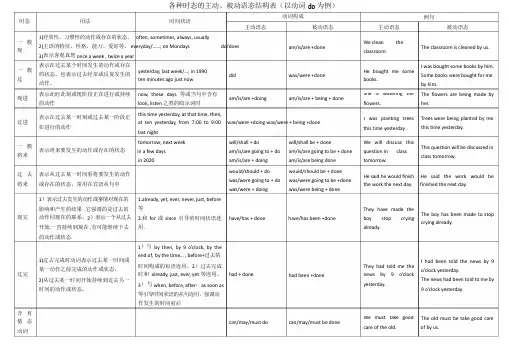
现进am/is/are+doing am/is/are+being+doneShe is watering the 过进I was planting treescan/may/must do can/may/must be done We must take good各种时态的主动、被动语态结构表(以动词do为例)时态用法时间状语动词构成主动语态被动语态主动语态例句被动语态一般现1)经常性、习惯性的动作或存在的状态。
often,sometimes,always,usually2)主语的特征、性格、能力、爱好等。
everyday/……;on Mondays do/does3)表示客观真理once a week,twice a yearam/is/are+doneWe clean theclassroom.The classroom is cleaned by us.一般过表示在过去某个时间发生的动作或存在的状态,也表示过去经常或反复发生的动作。
yesterday;last week/…;in1990ten minutes ago just nowdid was/were+doneHe bought me somebooks.I was bought some books by him.Some books were bought for meby him.表示此时此刻或现阶段正在进行或持续now,these days等或当句中含有的动作look,listen之类的暗示词时flowers.表示在过去某一时刻或过去某一阶段正在进行的动作this time yesterday.this time yesterday,at that time,then,at ten yesterday,from7:00to9:00was/were+doing was/were+being+donelast nightThe flowers are being made byher.Trees were being planted by methis time yesterday.一般将来tomorrow;next week表示将来要发生的动作或存在的状态in a few daysin2020will/shall+doam/is/are going to+doam/is/are+doingwill/shall be+doneam/is/are going to be+doneam/is/are being doneWe will discuss thisquestion in classtomorrow.This question will be discussed inclass tomorrow.过去将来表示从过去某一时间看将要发生的动作或存在的状态,常用在宾语从句中would/should+dowas/were going to+dowas/were+doingwould/should be+donewas/were going to be+donewas/were being+doneHe said he would finish He said the work would bethe work the next day.finished the next day.1)表示过去发生的动作或事情对现在的 1.already,yet,ever,never,just,before影响和产生的结果.它强调的是过去的现完动作同现在的联系。
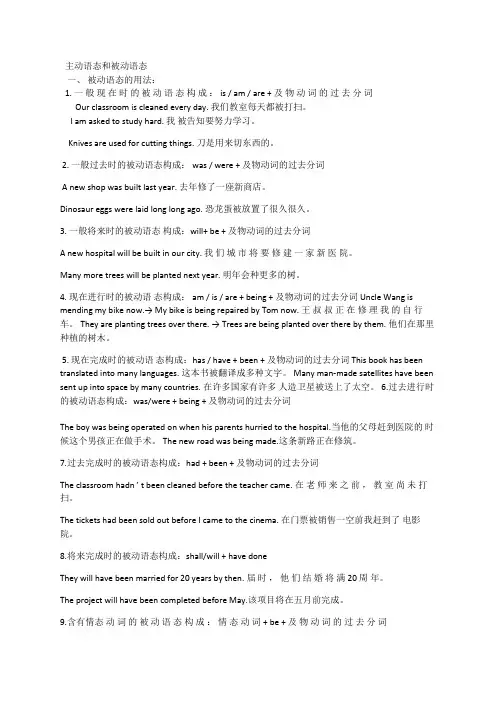
主动语态和被动语态一、被动语态的用法:1. 一般现在时的被动语态构成: is / am / are + 及物动词的过去分词Our classroom is cleaned every day. 我们教室每天都被打扫。
I am asked to study hard. 我被告知要努力学习。
Knives are used for cutting things. 刀是用来切东西的。
2. 一般过去时的被动语态构成: was / were + 及物动词的过去分词A new shop was built last year. 去年修了一座新商店。
Dinosaur eggs were laid long long ago. 恐龙蛋被放置了很久很久。
3. 一般将来时的被动语态构成:will+ be + 及物动词的过去分词A new hospital will be built in our city. 我们城市将要修建一家新医院。
Many more trees will be planted next year. 明年会种更多的树。
4. 现在进行时的被动语态构成: am / is / are + being + 及物动词的过去分词 Uncle Wang is mending my bike now.→ My bike is being repaired by Tom now. 王叔叔正在修理我的自行车。
They are planting trees over there. → Trees are being planted over there by them.他们在那里种植的树木。
5. 现在完成时的被动语态构成:has / have + been + 及物动词的过去分词 This book has been translated into many languages. 这本书被翻译成多种文字。
Many man-made satellites have been sent up into space by many countries. 在许多国家有许多人造卫星被送上了太空。
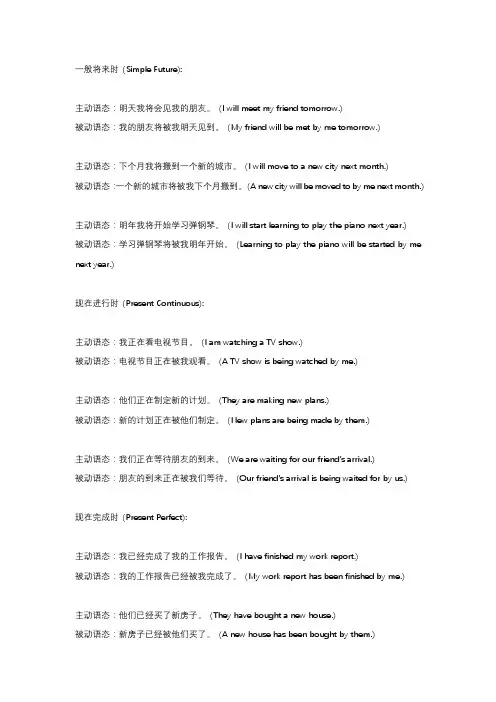
一般将来时(Simple Future):主动语态:明天我将会见我的朋友。
(I will meet my friend tomorrow.)被动语态:我的朋友将被我明天见到。
(My friend will be met by me tomorrow.)主动语态:下个月我将搬到一个新的城市。
(I will move to a new city next month.)被动语态:一个新的城市将被我下个月搬到。
(A new city will be moved to by me next month.)主动语态:明年我将开始学习弹钢琴。
(I will start learning to play the piano next year.)被动语态:学习弹钢琴将被我明年开始。
(Learning to play the piano will be started by me next year.)现在进行时(Present Continuous):主动语态:我正在看电视节目。
(I am watching a TV show.)被动语态:电视节目正在被我观看。
(A TV show is being watched by me.)主动语态:他们正在制定新的计划。
(They are making new plans.)被动语态:新的计划正在被他们制定。
(New plans are being made by them.)主动语态:我们正在等待朋友的到来。
(We are waiting for our friend's arrival.)被动语态:朋友的到来正在被我们等待。
(Our friend's arrival is being waited for by us.)现在完成时(Present Perfect):主动语态:我已经完成了我的工作报告。
(I have finished my work report.)被动语态:我的工作报告已经被我完成了。


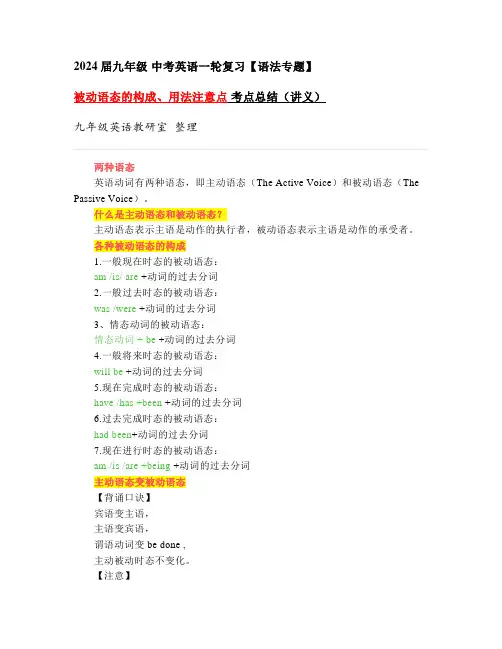
2024届九年级中考英语一轮复习【语法专题】被动语态的构成、用法注意点考点总结(讲义)九年级英语教研室整理两种语态英语动词有两种语态,即主动语态(The Active Voice)和被动语态(The Passive Voice)。
什么是主动语态和被动语态?主动语态表示主语是动作的执行者,被动语态表示主语是动作的承受者。
各种被动语态的构成1.一般现在时态的被动语态:am /is/ are +动词的过去分词2.一般过去时态的被动语态:was /were +动词的过去分词3、情态动词的被动语态:情态动词 + be +动词的过去分词4.一般将来时态的被动语态:will be +动词的过去分词5.现在完成时态的被动语态:have /has +been +动词的过去分词6.过去完成时态的被动语态:had been+动词的过去分词7.现在进行时态的被动语态:am /is /are +being +动词的过去分词主动语态变被动语态【背诵口诀】宾语变主语,主语变宾语,谓语动词变be done ,主动被动时态不变化。
【注意】❤️1.主动、被动的时态要一致。
❤️2.变成的被动语态的主语与谓语在单复数上保持一致。
同步训练:1.I broke the glass just now.2.Cats usually eat mice.3.Thousands of people plant many trees every year.4.Students have not cleaned the classroom yet.5.Eric shared his delicious cakes with his friends.6.Mo Yan will write a new book in three years.7.My father played cards on the Internet this morning.8.Workers have built two plastic factories so far .9.He gave me an EnglishEnglish dictionary.【两种】10.He speaks a liitle English and French.11.We saw the teacher enter the classroom happily.12.His jokes made the girl laugh.13.We should take care of the old men well.14.She has run out of her money.15.You must turn off the light before going to bed.参考答案1. The glass was broken just now by me.2. Mice are usually eaten by cats.3.Many trees are planted by thousands of people every year.4.The classroom has not been cleaned yet by students.5.His delicious cakes were shared with his friends by Eric.6.A new book will be written in three years by Mo Yan.7.Cards were played on the Internet by my father this morning.8.Two plastic factories have been built by workers so far.9.(1)I was given an EnglishEnglish dictionary by him.(2)An EnglishEnglish dictionary was given to me by him.10.A little English and French are spoken by him.11.The teacher was seen to enter the classroom happily by us.12.The girl was made to laugh by his jokes.13.The old men should be taken care of well by us.14.Her money has been run out of by her.15.The light must be turned off before going to bed by you.特殊情况被动语态(1)带双宾语的被动语态动词+ sb(间接宾语) +sth(直接宾语)背诵口诀:如遇双宾语,一般变间宾,若把直宾变,to /for 间宾连。
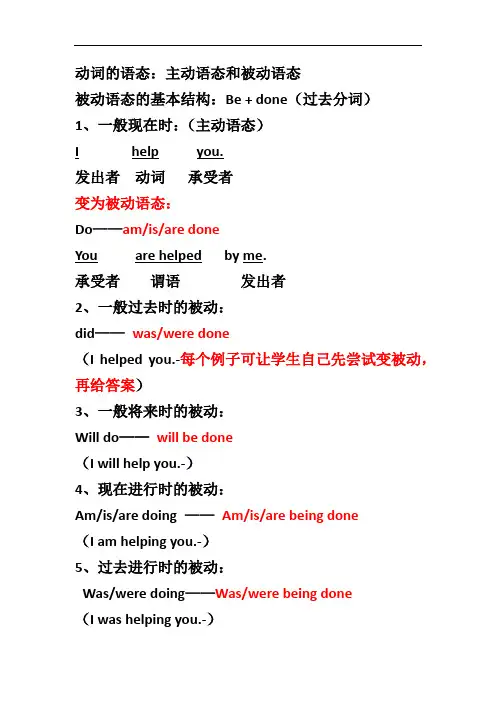
动词的语态:主动语态和被动语态被动语态的基本结构:Be + done(过去分词)1、一般现在时:(主动语态)I help you.发出者动词承受者变为被动语态:Do——am/is/are doneYou are helped by me.承受者谓语发出者2、一般过去时的被动:did——was/were done(I helped you.-每个例子可让学生自己先尝试变被动,再给答案)3、一般将来时的被动:Will do——will be done(I will help you.-)4、现在进行时的被动:Am/is/are doing ——Am/is/are being done(I am helping you.-)5、过去进行时的被动:Was/were doing——Was/were being done(I was helping you.-)6、现在完成时的被动:Have done——have been done (I have helped you.-)7、过去完成时的被动:Had done——had been done (I had helped you.-)8、过去将来时的被动:Would do ——would be done (I would help you.-)答案:2、You were helped by me.3、You will be helped by me.4、You are being helped by me.5、You were being helped by me.6、You have been helped by me.7、You had been helped by me.8、You would be helped by me.。
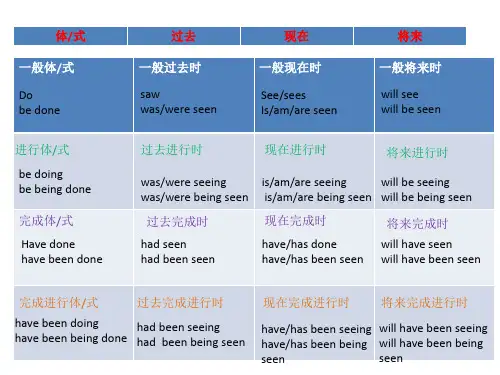
英语的16种时态及其被动语态例句英语的16种时态,及其动语态(be + V过去分词).第一句是主动语态,第二三句是被动。
1 一般现在时用动词原形I often watch TV。
TV is often watched by me。
2 一般过去时用动词过去时I watched TV just now。
TV was watched by me just now.3 现在进行时 be + vingI am watching TV.TV is being watched by me.4 过去进行时 was/were + vingI was watching TV when you came in.TV was being watched by me when you came in。
(注意点跟第3句相同)be going to + 动词原形 5 一般将来时 will + 动词原形或I will go to the zoo on Sunday。
The zoo will be visited by me on Sunday.(注意这里will可以用is going to代替)6 过去将来时 would + 动词原形或 was/were going to + 动词原形Yesterday he told me he would go to the zoo next Sunday。
Yesterday he told me the zoo would be visited by him next Sunday。
(单被动)Yesterday I was told by him the zoo would be visited by him next Sunday. (双被动) (注意,这里的would可以用 was going to 代替)7 现在完成时 have/has + v过去分词I have finished my homework。
被动语态比较主动语态与被动语态:(主动)The office (被动)(主动)The office was (被动)1、一般现在时的被动结构:am/is/are+done(过去分词)如:People in China speak Chinese. Chinese is spoken by people in China.2、一般过去时的被动结构:was/were+done如:Tom bought some cakes. Some cakes were bought by Tom.3、一般将来时的被动结构:shall/will be done.如:Our school will hold a sports meeting. A sports meeting will be held by our school.4、情态动词的被动结构:must/may/can/need/should+be done.如:We must send her to hospital. She must be sent to hospital by us.5、现在完成时的被冻结构:have/has been done.如:He has learned many words. Many words have been learned by him.6、现在进行时的被动结构:am/is/are being done如:the office is being cleaned at the moment.比较主动语态与被动语态(主动)The door is being painted7、感官动词没有被动,总是用于一般现在时或一般过去时基本时态1、一般现在时:用来表示一般性的事实或有时或往往发生的事情主语+动词标志词:always/never/often/sometimes/usually 等频度副词如:I like big cities. I don't like big cities.The shop open at 9 o'clock and close at 5.30.Sue always arrives at work early.I usually go to work by car but sometimes I walk.2、现在进行时am/is/are+doing如:Tom is having a shower at the moment.You can turn off the television.I'm not watching it.这些动词不用于现在进行时:Like/love/want/know/understand/remember/depend/prefer/ hate/need/mean/believe/forget如:I'm tired.I want to go home.(而非I'm wanting)‘Do you know that girl?’‘Yes,but I don't remember her name.’3、一般过去时:主语+动词过去时如:I/we/you/they/he/she/it+watchedThey watched television yesterday evening.①否定式:可用did/didn't+动词原形如:We went to the cinema but we didn't enjoy the film.②疑问句:did+主语+动词原形如:What did your sister phone you?Where did your parents go for their holiday?4、过去进行时was/were+doing如:What were you doing at 11:30 yesterday? Were you working?In 1985 we were living in Canada.5、现在完成时:have/has+done①表示过去发生的而现在有结果的动作如:I've lost my passport. (我现在找不到我的护照)We've bought a new car.(我们现在有了一辆新车)标志词:just/already/yetWe've already met.②谈论从过去到现在的一段时间如一个人的一生时,用现在完成时(have been/have had/have played)如:Have you ever been to Japan?(从过去到现在)‘Have you been to France?’(一生中)‘No,I haven't.’现在完成进行时+ ever (疑问句中)与never比较:‘Has Ann ever been to Australia?’‘Yes,once.’(once表示“一次”) My mother has never travelled bu air.(从来没有)④gone与been比较:Bill has gone to Spain.(他现在在西班牙)Bill has been to Spain.(他去了西班牙但是现在回来了,即曾经去过/到过)6、过去完成时:had+done表示发生的时间是“过去的过去”,侧重事情的结果如:When I woke up,it had already stopped raining.I had finished reading the novel by nine o'clock last night.。
我稍微整理了一下,一共有十六种时态。
十六种时态和他们的时间状语1.一般现在时(do /does )every day, every week , always ,usually, seldom ,never .2.一般过去时(did )yesterday , last week , ago ,the other day , just now, in the past , that day , from then on (不到现在)3.一般将来时(will do )Tomorrow ,this evening , next week , soon , at once , right away, in three minutes , justa moment.4.过去将来时(would do )the next day ,after three years ,three years later ,soon ,right away . (这些时间状语用于间接引语)5.现在进行时(am /is /are doing)now , just now , at the moment ,at present , always (带有感情色彩)6 过去进行时(was /were doing )at six yesterday evening ,from 7 to 9 yesterday evening ,at that time .7 现在完成时(have /has done )since , for some years , already , just , before, recently , so far , up till now , in t he past few years , the last ten years .8 过去完成时(had done )by +过去时间, three years before , up to the end of last year9 现在完成进行时(have /has been doing )these days , all the morning , all day long ,all the year round10 过去完成进行时(had been doing )in those day , all day (这些时间状语用于间接引语)11 将来进行时(shall/will be doing )at 8 tomorrow morning , from 2 to 3 tomorrow afternoon12 过去将来进行时(should /would be doing )at 8 the next morning ,from 7 to 8 the next morning13 将来完成时(shall /will have done )by 200814 过去将来完成时(should /would have done )by +将来时间(用于虚拟语气或间接引语), by the end of the next year15 将来完成进行时(shall /will have been doing )all tomorrow morning , all next week .16 过去将来完成进行时(should /would have been doing )all the next day , all the next week几个时态的比较1.did sth./have done sth.Who has taken away my umbrella?I can’t find it anywhere.Oh, Sally took it away just now.2.did sth./ had done sth.We learned six passages last week.We had learned six passages by the end of last week.3.have been doing/have done sth.They have repaired several cars.They have been repairing cars.语态:分为主动和被动。
英语16种时态和语态英语中的时态和语态有很多种,以下是其中16种时态和语态的一览表:1. 一般现在时(Simple Present Tense):表示经常性、习惯性的动作或真理。
例句:I eat breakfast every morning.(我每天早上吃早餐。
)2. 现在进行时(Present Continuous Tense):表示正在进行的动作。
例句:She is studying for her exams.(她正在为考试学习。
)3. 现在完成时(Present Perfect Tense):表示过去发生的动作对现在产生的影响。
例句:He has already finished his homework.(他已经完成了作业。
)4. 现在完成进行时(Present Perfect Continuous Tense):表示过去开始并一直持续到现在的动作。
例句:They have been playing basketball for two hours.(他们已经打了两个小时的篮球了。
)5. 一般过去时(Simple Past Tense):表示过去发生的动作或状态。
例句:I went to the park yesterday.(昨天我去了公园。
)6. 过去进行时(Past Continuous Tense):表示过去某一时刻正在进行的动作。
例句:She was watching TV when I called her.(我给她打电话时,她正在看电视。
)7. 过去完成时(Past Perfect Tense):表示过去某个时间点之前已经完成的动作。
例句:He had finished his work before he left.(他离开之前已经完成了他的工作。
)8. 过去完成进行时(Past Perfect Continuous Tense):表示过去某个时间点之前一直在进行的动作。
八种时态主动语态被动语态一般现在时(经常,反复,爱好,特点,条件,真理) do; does am;is;are done一般过去时(过去发生的事,不强调现在的结果) did; -ed was;were done一般将来时(将要发生的事) will do will be done现在进行时(现在正在发生的事) am;is;are doing am;is;are being done过去进行时(当时正在发生的事) was;were doing was;were being done现在完成时(过去发生的事,强调现在的结果) have;has done have;has been done过去完成时(过去完成的事;过去以前发生的事) had done had been done过去将来时(过去将要发生的事) would do would be done八种时态:• He is always ready to help others. 一般现在时• She often came to help us in those days.一般过去式• He is doing his homework now. 现在进行时• At that time she was doing her homework.过去进行时• I've written an article.现在完成时• By the end of last month. We had reviewed four books 。
过去完成时• It is going to rain.一般将来时• I asked who was going there. 过去将来时一般现在时1.概念:经常、反复发生的动作或行为及现在的某种状况。
2.时间状语:always, usually, often, sometimes, every week (day, year, month…), once a week, on Sundays,3.基本结构:动词原形(如主语为第三人称单数,动词上要改为第三人称单数形式)4.否定形式:am/is/are+not;此时态的谓语动词若为行为动词,则在其前加don't,如主语为第三人称单数,则用doesn't,同时还原行为动词。
各种时态的主动语态和被动语态:
主动语态被动语态
动词原形或+s/es 主语+am/is/are+done
1. 一般现在时主语+ 系动词am/is/are+表语主语+ Can/may/must+be+done
Can/may/must+动词原形
动词过去式主语+ was/were +done
was/were +表语主语+ could/might/had to +be+done 2. 一般过去时主语+ could/might/had to +动词原形
Will/shall +v 主语+ will/shall +be+done
3. 一般将来时主语+ am/is/are going to +v 主语+ am/is/are going to +be+done
am/is/are + to do 主语+am/is/are + to +be+done
would/should+v 主语+ would/should +be+done
4. 过去将来时主语+ was/were going to +do 主语+ was/were going to +be+done
Was/were+ to do 主语+ Was/were + to +be+done
5. 现在进行时主语主语+am/is/are+ being done
6. 过去进行时主语+was/were+doing 主语+ was/were + being done
7. 现在完成时主语+have/has+done 主语+ have/has+been done
8. 过去完成时主语+had+done 主语+had been done
9. 现在完成进行时主语+have/has+ been doing(无被动)
10. 过去完成进行时主语+had+ been doing(无被动)
注:系动词、不及物动词没有被动语态,但动词不定式to do有被动语态,即to be done。
主动语态变为被动语态
1.I teach him English every day.--------He is taught English by me every day.
主+谓+间宾+直宾+时间状语
(1)主动语态变为被动语态:主动语态的主语变为被动语态中by的宾语(人称代词由主
格变为宾格),主动语态的动词变为被动语态相应时态的被动语态(要按着各种时态的构成形式去变),主动语态的宾语变为被动语态的主语(人称代词由宾格变为主格)。
(2)主动语态变为被动语态,动词时态不能发生变化。
(3)人称代词的主格和宾格: 主格在句子中作主语,宾格在句子中作宾语。
人称代词的主格:主格在句子中作主语
I(我),you(你),he,she,it(他,她,它),we(我们),you(你们),they(他/她/它们)
人称代词的宾格:宾格在句子中作宾语,放在动词和介词之后。
me(我),you(你),him,her,it(他,她,它),us(我们),you(你们),them(他/她/它们)。